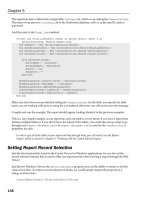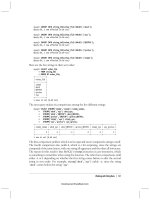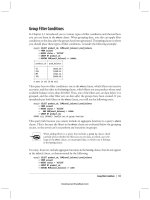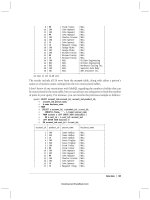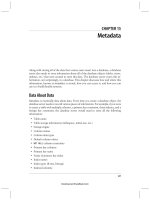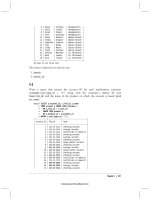Learning SQL Second Edition phần 8 potx
Bạn đang xem bản rút gọn của tài liệu. Xem và tải ngay bản đầy đủ của tài liệu tại đây (787.71 KB, 34 trang )
As the error message suggests, it is a reasonable practice to retry a transaction that has
been rolled back due to deadlock detection. However, if deadlocks become fairly com-
mon, then you may need to modify the applications that access the database to decrease
the probability of deadlocks (one common strategy is to ensure that data resources are
always accessed in the same order, such as always modifying account data before in-
serting transaction data).
Transaction Savepoints
In some cases, you may encounter an issue within a transaction that requires a rollback,
but you may not want to undo all of the work that has transpired. For these situations,
you can establish one or more savepoints within a transaction and use them to roll back
to a particular location within your transaction rather than rolling all the way back to
the start of the transaction.
Choosing a Storage Engine
When using Oracle Database or Microsoft SQL Server, a single set of code is responsible
for low-level database operations, such as retrieving a particular row from a table based
on primary key value. The MySQL server, however, has been designed so that multiple
storage engines may be utilized to provide low-level database functionality, including
resource locking and transaction management. As of version 6.0, MySQL includes the
following storage engines:
MyISAM
A nontransactional engine employing table locking
MEMORY
A nontransactional engine used for in-memory tables
BDB
A transactional engine employing page-level locking
InnoDB
A transactional engine employing row-level locking
Merge
A specialty engine used to make multiple identical MyISAM tables appear as a
single table (a.k.a. table partitioning)
Maria
A MyISAM replacement included in version 6.0.6 that adds full recovery
capabilities
Falcon
A new (as of 6.0.4) high-performance transactional engine employing row-level
locking
Archive
A specialty engine used to store large amounts of unindexed data, mainly for ar-
chival purposes
What Is a Transaction? | 223
Download at WoweBook.Com
Although you might think that you would be forced to choose a single storage engine
for your database, MySQL is flexible enough to allow you to choose a storage engine
on a table-by-table basis. For any tables that might take part in transactions, however,
you should choose the InnoDB or Falcon storage engine, which uses row-level locking
and versioning to provide the highest level of concurrency across the different storage
engines.
You may explicitly specify a storage engine when creating a table, or you can change
an existing table to use a different engine. If you do not know what engine is assigned
to a table, you can use the show table command, as demonstrated by the following:
mysql> SHOW TABLE STATUS LIKE 'transaction' \G
*************************** 1. row ***************************
Name: transaction
Engine: InnoDB
Version: 10
Row_format: Compact
Rows: 21
Avg_row_length: 780
Data_length: 16384
Max_data_length: 0
Index_length: 49152
Data_free: 0
Auto_increment: 22
Create_time: 2008-02-19 23:24:36
Update_time: NULL
Check_time: NULL
Collation: latin1_swedish_ci
Checksum: NULL
Create_options:
Comment:
1 row in set (1.46 sec)
Looking at the second item, you can see that the transaction table is already using the
InnoDB engine. If it were not, you could assign the InnoDB engine to the transaction
table via the following command:
ALTER TABLE transaction ENGINE = INNODB;
All savepoints must be given a name, which allows you to have multiple savepoints
within a single transaction. To create a savepoint named my_savepoint, you can do the
following:
SAVEPOINT my_savepoint;
To roll back to a particular savepoint, you simply issue the rollback command followed
by the keywords to savepoint and the name of the savepoint, as in:
ROLLBACK TO SAVEPOINT my_savepoint;
Here’s an example of how savepoints may be used:
START TRANSACTION;
UPDATE product
SET date_retired = CURRENT_TIMESTAMP()
224 | Chapter 12: Transactions
Download at WoweBook.Com
WHERE product_cd = 'XYZ';
SAVEPOINT before_close_accounts;
UPDATE account
SET status = 'CLOSED', close_date = CURRENT_TIMESTAMP(),
last_activity_date = CURRENT_TIMESTAMP()
WHERE product_cd = 'XYZ';
ROLLBACK TO SAVEPOINT before_close_accounts;
COMMIT;
The net effect of this transaction is that the mythical XYZ product is retired but none
of the accounts are closed.
When using savepoints, remember the following:
• Despite the name, nothing is saved when you create a savepoint. You must even-
tually issue a commit if you want your transaction to be made permanent.
• If you issue a rollback without naming a savepoint, all savepoints within the trans-
action will be ignored and the entire transaction will be undone.
If you are using SQL Server, you will need to use the proprietary command save
transaction to create a savepoint and rollback transaction to roll back to a savepoint,
with each command being followed by the savepoint name.
Test Your Knowledge
Test your understanding of transactions by working through the following exercise.
When you’re done, compare your solution with that in Appendix C.
Exercise 12-1
Generate a transaction to transfer $50 from Frank Tucker’s money market account to
his checking account. You will need to insert two rows into the transaction table and
update two rows in the account table.
Test Your Knowledge | 225
Download at WoweBook.Com
Download at WoweBook.Com
CHAPTER 13
Indexes and Constraints
Because the focus of this book is on programming techniques, the first 12 chapters
concentrated on elements of the SQL language that you can use to craft powerful
select, insert, update, and delete statements. However, other database features indi-
rectly affect the code you write. This chapter focuses on two of those features: indexes
and constraints.
Indexes
When you insert a row into a table, the database server does not attempt to put the
data in any particular location within the table. For example, if you add a row to the
department table, the server doesn’t place the row in numeric order via the dept_id
column or in alphabetical order via the name column. Instead, the server simply places
the data in the next available location within the file (the server maintains a list of free
space for each table). When you query the department table, therefore, the server will
need to inspect every row of the table to answer the query. For example, let’s say that
you issue the following query:
mysql> SELECT dept_id, name
-> FROM department
-> WHERE name LIKE 'A%';
+ + +
| dept_id | name |
+ + +
| 3 | Administration |
+ + +
1 row in set (0.03 sec)
To find all departments whose name begins with A, the server must visit each row in
the department table and inspect the contents of the name column; if the department
name begins with A, then the row is added to the result set. This type of access is known
as a table scan.
227
Download at WoweBook.Com
While this method works fine for a table with only three rows, imagine how long it
might take to answer the query if the table contains 3 million rows. At some number
of rows larger than three and smaller than 3 million, a line is crossed where the server
cannot answer the query within a reasonable amount of time without additional help.
This help comes in the form of one or more indexes on the department table.
Even if you have never heard of a database index, you are certainly aware of what an
index is (e.g., this book has one). An index is simply a mechanism for finding a specific
item within a resource. Each technical publication, for example, includes an index at
the end that allows you to locate a specific word or phrase within the publication. The
index lists these words and phrases in alphabetical order, allowing the reader to move
quickly to a particular letter within the index, find the desired entry, and then find the
page or pages on which the word or phrase may be found.
In the same way that a person uses an index to find words within a publication, a
database server uses indexes to locate rows in a table. Indexes are special tables that,
unlike normal data tables, are kept in a specific order. Instead of containing all of the
data about an entity, however, an index contains only the column (or columns) used
to locate rows in the data table, along with information describing where the rows are
physically located. Therefore, the role of indexes is to facilitate the retrieval of a subset
of a table’s rows and columns without the need to inspect every row in the table.
Index Creation
Returning to the department table, you might decide to add an index on the name column
to speed up any queries that specify a full or partial department name, as well as any
update or delete operations that specify a department name. Here’s how you can add
such an index to a MySQL database:
mysql> ALTER TABLE department
-> ADD INDEX dept_name_idx (name);
Query OK, 3 rows affected (0.08 sec)
Records: 3 Duplicates: 0 Warnings: 0
This statement creates an index (a B-tree index to be precise, but more on this shortly)
on the department.name column; furthermore, the index is given the name
dept_name_idx. With the index in place, the query optimizer (which we discussed in
Chapter 3) can choose to use the index if it is deemed beneficial to do so (with only
three rows in the department table, for example, the optimizer might very well choose
to ignore the index and read the entire table). If there is more than one index on a table,
the optimizer must decide which index will be the most beneficial for a particular SQL
statement.
228 | Chapter 13: Indexes and Constraints
Download at WoweBook.Com
MySQL treats indexes as optional components of a table, which is why
you must use the alter table command to add or remove an index.
Other database servers, including SQL Server and Oracle Database,
treat indexes as independent schema objects. For both SQL Server and
Oracle, therefore, you would generate an index using the create
index command, as in:
CREATE INDEX dept_name_idx
ON department (name);
As of MySQL version 5.0, a create index command is available, al-
though it is mapped to the alter table command.
All database servers allow you to look at the available indexes. MySQL users can use
the show command to see all of the indexes on a specific table, as in:
mysql> SHOW INDEX FROM department \G *************************** 1. row
*************************** 1. row ***************************
Table: department
Non_unique: 0
Key_name: PRIMARY
Seq_in_index: 1
Column_name: dept_id
Collation: A
Cardinality: 3
Sub_part: NULL
Packed: NULL
Null:
Index_type: BTREE
Comment:
Index_Comment:
*************************** 2. row ***************************
Table: department
Non_unique: 1
Key_name: dept_name_idx
Seq_in_index: 1
Column_name: name
Collation: A
Cardinality: 3
Sub_part: NULL
Packed: NULL
Null:
Index_type: BTREE
Comment:
Index_Comment:
2 rows in set (0.01 sec)
The output shows that there are two indexes on the department table: one on the
dept_id column called PRIMARY, and the other on the name column called
dept_name_idx. Since I have created only one index so far (dept_name_idx), you might
be wondering where the other came from; when the department table was created, the
Indexes | 229
Download at WoweBook.Com
create table statement included a constraint naming the dept_id column as the pri-
mary key for the table. Here’s the statement used to create the table:
CREATE TABLE department
(dept_id SMALLINT UNSIGNED NOT NULL AUTO_INCREMENT,
name VARCHAR(20) NOT NULL,
CONSTRAINT pk_department PRIMARY KEY (dept_id) );
When the table was created, the MySQL server automatically generated an index on
the primary key column, which, in this case, is dept_id, and gave the index the name
PRIMARY. I cover constraints later in this chapter.
If, after creating an index, you decide that the index is not proving useful, you can
remove it via the following:
mysql> ALTER TABLE department
-> DROP INDEX dept_name_idx;
Query OK, 3 rows affected (0.02 sec)
Records: 3 Duplicates: 0 Warnings: 0
SQL Server and Oracle Database users must use the drop index com-
mand to remove an index, as in:
DROP INDEX dept_name_idx; (Oracle)
DROP INDEX dept_name_idx ON department (SQL Server)
MySQL now also supports a drop index command.
Unique indexes
When designing a database, it is important to consider which columns are allowed to
contain duplicate data and which are not. For example, it is allowable to have two
customers named John Smith in the individual table since each row will have a different
identifier (cust_id), birth date, and tax number (customer.fed_id) to help tell them
apart. You would not, however, want to allow two departments with the same name
in the department table. You can enforce a rule against duplicate department names by
creating a unique index on the department.name column.
A unique index plays multiple roles in that, along with providing all the benefits of a
regular index, it also serves as a mechanism for disallowing duplicate values in the
indexed column. Whenever a row is inserted or when the indexed column is modified,
the database server checks the unique index to see whether the value already exists in
another row in the table. Here’s how you would create a unique index on the
department.name column:
mysql> ALTER TABLE department
-> ADD UNIQUE dept_name_idx (name);
Query OK, 3 rows affected (0.04 sec)
Records: 3 Duplicates: 0 Warnings: 0
230 | Chapter 13: Indexes and Constraints
Download at WoweBook.Com
SQL Server and Oracle Database users need only add the unique key-
word when creating an index, as in:
CREATE UNIQUE INDEX dept_name_idx
ON department (name);
With the index in place, you will receive an error if you try to add another department
with the name 'Operations':
mysql> INSERT INTO department (dept_id, name)
-> VALUES (999, 'Operations');
ERROR 1062 (23000): Duplicate entry 'Operations' for key 'dept_name_idx'
You should not build unique indexes on your primary key column(s), since the server
already checks uniqueness for primary key values. You may, however, create more than
one unique index on the same table if you feel that it is warranted.
Multicolumn indexes
Along with the single-column indexes demonstrated thus far, you may build indexes
that span multiple columns. If, for example, you find yourself searching for employees
by first and last names, you can build an index on both columns together, as in:
mysql> ALTER TABLE employee
-> ADD INDEX emp_names_idx (lname, fname);
Query OK, 18 rows affected (0.10 sec)
Records: 18 Duplicates: 0 Warnings: 0
This index will be useful for queries that specify the first and last names or just the last
name, but you cannot use it for queries that specify only the employee’s first name. To
understand why, consider how you would find a person’s phone number; if you know
the person’s first and last names, you can use a phone book to find the number quickly,
since a phone book is organized by last name and then by first name. If you know only
the person’s first name, you would need to scan every entry in the phone book to find
all the entries with the specified first name.
When building multiple-column indexes, therefore, you should think carefully about
which column to list first, which column to list second, and so on so that the index is
as useful as possible. Keep in mind, however, that there is nothing stopping you from
building multiple indexes using the same set of columns but in a different order if you
feel that it is needed to ensure adequate response time.
Types of Indexes
Indexing is a powerful tool, but since there are many different types of data, a single
indexing strategy doesn’t always do the job. The following sections illustrate the dif-
ferent types of indexing available from various servers.
Indexes | 231
Download at WoweBook.Com
B-tree indexes
All the indexes shown thus far are balanced-tree indexes, which are more commonly
known as B-tree indexes. MySQL, Oracle Database, and SQL Server all default to B-
tree indexing, so you will get a B-tree index unless you explicitly ask for another type.
As you might expect, B-tree indexes are organized as trees, with one or more levels of
branch nodes leading to a single level of leaf nodes. Branch nodes are used for navigating
the tree, while leaf nodes hold the actual values and location information. For example,
a B-tree index built on the employee.lname column might look something like Fig-
ure 13-1.
A - M
N - Z
A - C
D - F
G - I
J - M
N - P
Q - S
T - V
W - Z
Barker
Blake
Fleming
Fowler
Gooding
Grossman
Hawthorne
Jameson
Markham
Mason
Parker
Portman
Roberts
Smith
Tucker
Tulman
Tyler
Ziegler
Figure 13-1. B-tree example
If you were to issue a query to retrieve all employees whose last name starts with G, the
server would look at the top branch node (called the root node) and follow the link to
the branch node that handles last names beginning with A through M. This branch
node would, in turn, direct the server to a leaf node containing last names beginning
with G through I. The server then starts reading the values in the leaf node until it
encounters a value that doesn’t begin with G (which, in this case, is 'Hawthorne').
As rows are inserted, updated, and deleted from the employee table, the server will
attempt to keep the tree balanced so that there aren’t far more branch/leaf nodes on
one side of the root node than the other. The server can add or remove branch nodes
to redistribute the values more evenly and can even add or remove an entire level of
branch nodes. By keeping the tree balanced, the server is able to traverse quickly to the
leaf nodes to find the desired values without having to navigate through many levels of
branch nodes.
232 | Chapter 13: Indexes and Constraints
Download at WoweBook.Com
Bitmap indexes
Although B-tree indexes are great at handling columns that contain many different
values, such as a customer’s first/last names, they can become unwieldy when built on
a column that allows only a small number of values. For example, you may decide to
generate an index on the account.product_cd column so that you can quickly retrieve
all accounts of a specific type (e.g., checking, savings). Because there are only eight
different products, however, and because some products are far more popular than
others, it can be difficult to maintain a balanced B-tree index as the number of accounts
grows.
For columns that contain only a small number of values across a large number of rows
(known as low-cardinality data), a different indexing strategy is needed. To handle this
situation more efficiently, Oracle Database includes bitmap indexes, which generate a
bitmap for each value stored in the column. Figure 13-2 shows what a bitmap index
might look like for data in the account.product_cd column.
Value/row
BUS
CD
CHK
MM
SAV
SBL
1
0
0
1
0
0
000000000000000000000001
10010001000000100000000
00000100100000001000000
00101010011001010010010
01000000000110000100000
00000000000000000001100
2 3 4 5 6 7 8 9 101112131415161718192021222324
Figure 13-2. Bitmap example
The index contains six bitmaps, one for each value in the product_cd column (two of
the eight available products are not being used), and each bitmap includes a 0/1 value
for each of the 24 rows in the account table. Thus, if you ask the server to retrieve all
money market accounts (product_cd = 'MM'), the server simply finds all the 1 values in
the MM bitmap and returns rows 7, 10, and 18. The server can also combine bitmaps if
you are looking for multiple values; for example, if you want to retrieve all money
market and savings accounts (product_cd = 'MM' or product_cd = 'SAV'), the server can
perform an OR operation on the MM and SAV bitmaps and return rows 2, 5, 7, 9, 10, 16,
and 18.
Bitmap indexes are a nice, compact indexing solution for low-cardinality data, but this
indexing strategy breaks down if the number of values stored in the column climbs too
high in relation to the number of rows (known as high-cardinality data), since the server
would need to maintain too many bitmaps. For example, you would never build a
Indexes | 233
Download at WoweBook.Com
bitmap index on your primary key column, since this represents the highest possible
cardinality (a different value for every row).
Oracle users can generate bitmap indexes by simply adding the bitmap keyword to the
create index statement, as in:
CREATE BITMAP INDEX acc_prod_idx ON account (product_cd);
Bitmap indexes are commonly used in data warehousing environments, where large
amounts of data are generally indexed on columns containing relatively few values (e.g.,
sales quarters, geographic regions, products, salespeople).
Text indexes
If your database stores documents, you may need to allow users to search for words or
phrases in the documents. You certainly don’t want the server to open each document
and scan for the desired text each time a search is requested, but traditional indexing
strategies don’t work for this situation. To handle this situation, MySQL, SQL Server,
and Oracle Database include specialized indexing and search mechanisms for docu-
ments; both SQL Server and MySQL include what they call full-text indexes (for
MySQL, full-text indexes are available only with its MyISAM storage engine), and
Oracle Database includes a powerful set of tools known as Oracle Text. Document
searches are specialized enough that I refrain from showing an example, but I wanted
you to at least know what is available.
How Indexes Are Used
Indexes are generally used by the server to quickly locate rows in a particular table,
after which the server visits the associated table to extract the additional information
requested by the user. Consider the following query:
mysql> SELECT emp_id, fname, lname
-> FROM employee
-> WHERE emp_id IN (1, 3, 9, 15);
+ + + +
| emp_id | fname | lname |
+ + + +
| 1 | Michael | Smith |
| 3 | Robert | Tyler |
| 9 | Jane | Grossman |
| 15 | Frank | Portman |
+ + + +
4 rows in set (0.00 sec)
For this query, the server can use the primary key index on the emp_id column to locate
employee IDs 1, 3, 9, and 15 in the employee table, and then visit each of the four rows
to retrieve the first and last name columns.
234 | Chapter 13: Indexes and Constraints
Download at WoweBook.Com
If the index contains everything needed to satisfy the query, however, the server doesn’t
need to visit the associated table. To illustrate, let’s look at how the query optimizer
approaches the same query with different indexes in place.
The query, which aggregates account balances for specific customers, looks as follows:
mysql> SELECT cust_id, SUM(avail_balance) tot_bal
-> FROM account
-> WHERE cust_id IN (1, 5, 9, 11)
-> GROUP BY cust_id;
+ + +
| cust_id | tot_bal |
+ + +
| 1 | 4557.75 |
| 5 | 2237.97 |
| 9 | 10971.22 |
| 11 | 9345.55 |
+ + +
4 rows in set (0.00 sec)
To see how MySQL’s query optimizer decides to execute the query, I use the explain
statement to ask the server to show the execution plan for the query rather than exe-
cuting the query:
mysql> EXPLAIN SELECT cust_id, SUM(avail_balance) tot_bal
-> FROM account
-> WHERE cust_id IN (1, 5, 9, 11)
-> GROUP BY cust_id \G
*************************** 1. row ***************************
id: 1
select_type: SIMPLE
table: account
type: index
possible_keys: fk_a_cust_id
key: fk_a_cust_id
key_len: 4
ref: NULL
rows: 24
Extra: Using where
1 row in set (0.00 sec)
Each database server includes tools to allow you to see how the query
optimizer handles your SQL statement. SQL Server allows you to see an
execution plan by issuing the statement set showplan_text on before
running your SQL statement. Oracle Database includes the explain
plan statement, which writes the execution plan to a special table called
plan_table.
Without going into too much detail, here’s what the execution plan tells you:
Indexes | 235
Download at WoweBook.Com
• The fk_a_cust_id index is used to find the rows in the account table that satisfy the
where clause.
• After reading the index, the server expects to read all 24 rows of the account table
to gather the available balance data, since it doesn’t know that there might be other
customers besides IDs 1, 5, 9, and 11.
The fk_a_cust_id index is another index generated automatically by the server, but this
time it is because of a foreign key constraint rather than a primary key constraint (more
on this later in the chapter). The fk_a_cust_id index is built on the account.cust_id
column, so the server is using the index to locate customer IDs 1, 5, 9, and 11 in the
account table and is then visiting those rows to retrieve and aggregate the available
balance data.
Next, I will add a new index called acc_bal_idx on both the cust_id and
avail_balance columns:
mysql> ALTER TABLE account
-> ADD INDEX acc_bal_idx (cust_id, avail_balance);
Query OK, 24 rows affected (0.03 sec)
Records: 24 Duplicates: 0 Warnings: 0
With this index in place, let’s see how the query optimizer approaches the same query:
mysql> EXPLAIN SELECT cust_id, SUM(avail_balance) tot_bal
-> FROM account
-> WHERE cust_id IN (1, 5, 9, 11)
-> GROUP BY cust_id \G
*************************** 1. row ***************************
id: 1
select_type: SIMPLE
table: account
type: range
possible_keys: acc_bal_idx
key: acc_bal_idx
key_len: 4
ref: NULL
rows: 8
Extra: Using where; Using index
1 row in set (0.01 sec)
Comparing the two execution plans yields the following differences:
• The optimizer is using the new acc_bal_idx index instead of the fk_a_cust_id
index.
• The optimizer anticipates needing only eight rows instead of 24.
• The account table is not needed (designated by Using index in the Extra column)
to satisfy the query results.
Therefore, the server can use indexes to help locate rows in the associated table, or the
server can use an index as though it were a table as long as the index contains all the
columns needed by the query.
236 | Chapter 13: Indexes and Constraints
Download at WoweBook.Com
The process that I just led you through is an example of query tuning.
Tuning involves looking at an SQL statement and determining the re-
sources available to the server to execute the statement. You can decide
to modify the SQL statement, to adjust the database resources, or to do
both in order to make a statement run more efficiently. Tuning is a
detailed topic, and I strongly urge you to either read your server’s tuning
guide or pick up a good tuning book so that you can see all the different
approaches available for your server.
The Downside of Indexes
If indexes are so great, why not index everything? Well, the key to understanding why
more indexes are not necessarily a good thing is to keep in mind that every index is a
table (a special type of table, but still a table). Therefore, every time a row is added to
or removed from a table, all indexes on that table must be modified. When a row is
updated, any indexes on the column or columns that were affected need to be modified
as well. Therefore, the more indexes you have, the more work the server needs to do
to keep all schema objects up-to-date, which tends to slow things down.
Indexes also require disk space as well as some amount of care from your administra-
tors, so the best strategy is to add an index when a clear need arises. If you need an
index for only special purposes, such as a monthly maintenance routine, you can always
add the index, run the routine, and then drop the index until you need it again. In the
case of data warehouses, where indexes are crucial during business hours as users run
reports and ad hoc queries but are problematic when data is being loaded into the
warehouse overnight, it is a common practice to drop the indexes before data is loaded
and then re-create them before the warehouse opens for business.
In general, you should strive to have neither too many indexes nor too few. If you aren’t
sure how many indexes you should have, you can use this strategy as a default:
• Make sure all primary key columns are indexed (most servers automatically create
unique indexes when you create primary key constraints). For multicolumn pri-
mary keys, consider building additional indexes on a subset of the primary key
columns, or on all the primary key columns but in a different order than the primary
key constraint definition.
• Build indexes on all columns that are referenced in foreign key constraints. Keep
in mind that the server checks to make sure there are no child rows when a parent
is deleted, so it must issue a query to search for a particular value in the column.
If there’s no index on the column, the entire table must be scanned.
• Index any columns that will frequently be used to retrieve data. Most date columns
are good candidates, along with short (3- to 50-character) string columns.
After you have built your initial set of indexes, try to capture actual queries against your
tables, and modify your indexing strategy to fit the most-common access paths.
Indexes | 237
Download at WoweBook.Com
Constraints
A constraint is simply a restriction placed on one or more columns of a table. There are
several different types of constraints, including:
Primary key constraints
Identify the column or columns that guarantee uniqueness within a table
Foreign key constraints
Restrict one or more columns to contain only values found in another table’s pri-
mary key columns, and may also restrict the allowable values in other tables if
update cascade or delete cascade rules are established
Unique constraints
Restrict one or more columns to contain unique values within a table (primary key
constraints are a special type of unique constraint)
Check constraints
Restrict the allowable values for a column
Without constraints, a database’s consistency is suspect. For example, if the server
allows you to change a customer’s ID in the customer table without changing the same
customer ID in the account table, then you will end up with accounts that no longer
point to valid customer records (known as orphaned rows). With primary and foreign
key constraints in place, however, the server will either raise an error if an attempt is
made to modify or delete data that is referenced by other tables, or propagate the
changes to other tables for you (more on this shortly).
If you want to use foreign key constraints with the MySQL server, you
must use the InnoDB storage engine for your tables. Foreign key con-
straints are not supported in the Falcon engine as of version 6.0.4, but
they will be supported in later versions.
Constraint Creation
Constraints are generally created at the same time as the associated table via the create
table statement. To illustrate, here’s an example from the schema generation script for
this book’s example database:
CREATE TABLE product
(product_cd VARCHAR(10) NOT NULL,
name VARCHAR(50) NOT NULL,
product_type_cd VARCHAR (10) NOT NULL,
date_offered DATE,
date_retired DATE,
CONSTRAINT fk_product_type_cd FOREIGN KEY (product_type_cd)
REFERENCES product_type (product_type_cd),
CONSTRAINT pk_product PRIMARY KEY (product_cd)
);
238 | Chapter 13: Indexes and Constraints
Download at WoweBook.Com
The product table includes two constraints: one to specify that the product_cd column
serves as the primary key for the table, and another to specify that the
product_type_cd column serves as a foreign key to the product_type table. Alternatively,
you can create the product table without constraints, and add the primary and foreign
key constraints later via alter table statements:
ALTER TABLE product
ADD CONSTRAINT pk_product PRIMARY KEY (product_cd);
ALTER TABLE product
ADD CONSTRAINT fk_product_type_cd FOREIGN KEY (product_type_cd)
REFERENCES product_type (product_type_cd);
If you want to remove a primary or foreign key constraint, you can use the alter
table statement again, except that you specify drop instead of add, as in:
ALTER TABLE product
DROP PRIMARY KEY;
ALTER TABLE product
DROP FOREIGN KEY fk_product_type_cd;
While it is unusual to drop a primary key constraint, foreign key constraints are some-
times dropped during certain maintenance operations and then reestablished.
Constraints and Indexes
As you saw earlier in the chapter, constraint creation sometimes involves the automatic
generation of an index. However, database servers behave differently regarding the
relationship between constraints and indexes. Table 13-1 shows how MySQL, SQL
Server, and Oracle Database handle the relationship between constraints and indexes.
Table 13-1. Constraint generation
Constraint type MySQL SQL Server Oracle Database
Primary key constraints Generates unique index Generates unique index Uses existing index or creates new index
Foreign key constraints Generates index Does not generate index Does not generate index
Unique constraints Generates unique index Generates unique index Uses existing index or creates new index
MySQL, therefore, generates a new index to enforce primary key, foreign key, and
unique constraints, SQL Server generates a new index for primary key and unique
constraints but not for foreign key constraints, and Oracle Database takes the same
approach as SQL Server except that Oracle will use an existing index (if an appropriate
one exists) to enforce primary key and unique constraints. Although neither SQL Server
nor Oracle Database generates an index for a foreign key constraint, both servers’ doc-
umentation advises that indexes be created for every foreign key.
Constraints | 239
Download at WoweBook.Com
Cascading Constraints
With foreign key constraints in place, if a user attempts to insert a new row or change
an existing row such that a foreign key column doesn’t have a matching value in the
parent table, the server raises an error. To illustrate, here’s a look at the data in the
product and product_type tables:
mysql> SELECT product_type_cd, name
-> FROM product_type;
+ + +
| product_type_cd | name |
+ + +
| ACCOUNT | Customer Accounts |
| INSURANCE | Insurance Offerings |
| LOAN | Individual and Business Loans |
+ + +
3 rows in set (0.00 sec)
mysql> SELECT product_type_cd, product_cd, name
-> FROM product
-> ORDER BY product_type_cd;
+ + + +
| product_type_cd | product_cd | name |
+ + + +
| ACCOUNT | CD | certificate of deposit |
| ACCOUNT | CHK | checking account |
| ACCOUNT | MM | money market account |
| ACCOUNT | SAV | savings account |
| LOAN | AUT | auto loan |
| LOAN | BUS | business line of credit |
| LOAN | MRT | home mortgage |
| LOAN | SBL | small business loan |
+ + + +
8 rows in set (0.01 sec)
There are three different values for the product_type_cd column in the product_type
table (ACCOUNT, INSURANCE, and LOAN). Of the three values, two of them (ACCOUNT and
LOAN) are referenced in the product table’s product_type_cd column.
The following statement attempts to change the product_type_cd column in the
product table to a value that doesn’t exist in the product_type table:
mysql> UPDATE product
-> SET product_type_cd = 'XYZ'
-> WHERE product_type_cd = 'LOAN';
ERROR 1452 (23000): Cannot add or update a child row: a foreign key constraint
fails ('bank'.'product', CONSTRAINT 'fk_product_type_cd' FOREIGN KEY
('product_type_cd') REFERENCES 'product_type' ('product_type_cd'))
Because of the foreign key constraint on the product.product_type_cd column, the
server does not allow the update to succeed, since there is no row in the
product_type table with a value of XYZ in the product_type_cd column. Thus, the foreign
240 | Chapter 13: Indexes and Constraints
Download at WoweBook.Com
key constraint doesn’t let you change a child row if there is no corresponding value in
the parent.
What would happen, however, if you tried to change the parent row in the
product_type table to XYZ? Here’s an update statement that attempts to change the
LOAN product type to XYZ:
mysql> UPDATE product_type
-> SET product_type_cd = 'XYZ'
-> WHERE product_type_cd = 'LOAN';
ERROR 1451 (23000): Cannot delete or update a parent row: a foreign key
constraint fails ('bank'.'product', CONSTRAINT 'fk_product_type_cd' FOREIGN KEY
('product_type_cd') REFERENCES 'product_type' ('product_type_cd'))
Once again, an error is raised; this time because there are child rows in the product
table whose product_type_cd column contains the value LOAN. This is the default be-
havior for foreign key constraints, but it is not the only possible behavior; instead, you
can instruct the server to propagate the change to all child rows for you, thus preserving
the integrity of the data. Known as a cascading update, this variation of the foreign key
constraint can be installed by removing the existing foreign key and adding a new one
that includes the on update cascade clause:
mysql> ALTER TABLE product
-> DROP FOREIGN KEY fk_product_type_cd;
Query OK, 8 rows affected (0.02 sec)
Records: 8 Duplicates: 0 Warnings: 0
mysql> ALTER TABLE product
-> ADD CONSTRAINT fk_product_type_cd FOREIGN KEY (product_type_cd)
-> REFERENCES product_type (product_type_cd)
-> ON UPDATE CASCADE;
Query OK, 8 rows affected (0.03 sec)
Records: 8 Duplicates: 0 Warnings: 0
With this modified constraint in place, let’s see what happens when the previous
update statement is attempted again:
mysql> UPDATE product_type
-> SET product_type_cd = 'XYZ'
-> WHERE product_type_cd = 'LOAN';
Query OK, 1 row affected (0.01 sec)
Rows matched: 1 Changed: 1 Warnings: 0
This time, the statement succeeds. To verify that the change was propagated to the
product table, here’s another look at the data in both tables:
mysql> SELECT product_type_cd, name
-> FROM product_type;
+ + +
| product_type_cd | name |
+ + +
| ACCOUNT | Customer Accounts |
| INSURANCE | Insurance Offerings |
| XYZ | Individual and Business Loans |
Constraints | 241
Download at WoweBook.Com
+ + +
3 rows in set (0.02 sec)
mysql> SELECT product_type_cd, product_cd, name
-> FROM product
-> ORDER BY product_type_cd;
+ + + +
| product_type_cd | product_cd | name |
+ + + +
| ACCOUNT | CD | certificate of deposit |
| ACCOUNT | CHK | checking account |
| ACCOUNT | MM | money market account |
| ACCOUNT | SAV | savings account |
| XYZ | AUT | auto loan |
| XYZ | BUS | business line of credit |
| XYZ | MRT | home mortgage |
| XYZ | SBL | small business loan |
+ + + +
8 rows in set (0.01 sec)
As you can see, the change to the product_type table has been propagated to the
product table as well. Along with cascading updates, you can specify cascading dele-
tes as well. A cascading delete removes rows from the child table when a row is deleted
from the parent table. To specify cascading deletes, use the on delete cascade clause,
as in:
ALTER TABLE product
ADD CONSTRAINT fk_product_type_cd FOREIGN KEY (product_type_cd)
REFERENCES product_type (product_type_cd)
ON UPDATE CASCADE
ON DELETE CASCADE;
With this version of the constraint in place, the server will now update child rows in
the product table when a row in the product_type table is updated, as well as delete
child rows in the product table when a row in the product_type table is deleted.
Cascading constraints are one case in which constraints do directly affect the code that
you write. You need to know which constraints in your database specify cascading
updates and/or deletes so that you know the full effect of your update and delete
statements.
Test Your Knowledge
Work through the following exercises to test your knowledge of indexes and con-
straints. When you’re done, compare your solutions with those in Appendix C.
242 | Chapter 13: Indexes and Constraints
Download at WoweBook.Com
Exercise 13-1
Modify the account table so that customers may not have more than one account for
each product.
Exercise 13-2
Generate a multicolumn index on the transaction table that could be used by both of
the following queries:
SELECT txn_date, account_id, txn_type_cd, amount
FROM transaction
WHERE txn_date > cast('2008-12-31 23:59:59' as datetime);
SELECT txn_date, account_id, txn_type_cd, amount
FROM transaction
WHERE txn_date > cast('2008-12-31 23:59:59' as datetime)
AND amount < 1000;
Test Your Knowledge | 243
Download at WoweBook.Com
Download at WoweBook.Com
CHAPTER 14
Views
Well-designed applications generally expose a public interface while keeping imple-
mentation details private, thereby enabling future design changes without impacting
end users. When designing your database, you can achieve a similar result by keeping
your tables private and allowing your users to access data only through a set of views.
This chapter strives to define what views are, how they are created, and when and how
you might want to use them.
What Are Views?
A view is simply a mechanism for querying data. Unlike tables, views do not involve
data storage; you won’t need to worry about views filling up your disk space. You create
a view by assigning a name to a select statement, and then storing the query for others
to use. Other users can then use your view to access data just as though they were
querying tables directly (in fact, they may not even know they are using a view).
As a simple example, let’s say that you want to partially obscure the federal IDs (Social
Security numbers and corporate identifiers) in the customer table. The customer service
department, for example, may need access to just the last portion of the federal ID in
order to verify the identity of a caller, but exposing the entire number would violate
the company’s privacy policy. Therefore, instead of allowing direct access to the
customer table, you define a view called customer_vw and mandate that all bank per-
sonnel use it to access customer data. Here’s the view definition:
CREATE VIEW customer_vw
(cust_id,
fed_id,
cust_type_cd,
address,
city,
state,
zipcode
)
AS
SELECT cust_id,
245
Download at WoweBook.Com
concat('ends in ', substr(fed_id, 8, 4)) fed_id,
cust_type_cd,
address,
city,
state,
postal_code
FROM customer;
The first part of the statement lists the view’s column names, which may be different
from those of the underlying table (e.g., the customer_vw view has a column named
zipcode which maps to the customer.postal_code column). The second part of the
statement is a select statement, which must contain one expression for each column
in the view.
When the create view statement is executed, the database server simply stores the view
definition for future use; the query is not executed, and no data is retrieved or stored.
Once the view has been created, users can query it just like they would a table, as in:
mysql> SELECT cust_id, fed_id, cust_type_cd
-> FROM customer_vw;
+ + + +
| cust_id | fed_id | cust_type_cd |
+ + + +
| 1 | ends in 1111 | I |
| 2 | ends in 2222 | I |
| 3 | ends in 3333 | I |
| 4 | ends in 4444 | I |
| 5 | ends in 5555 | I |
| 6 | ends in 6666 | I |
| 7 | ends in 7777 | I |
| 8 | ends in 8888 | I |
| 9 | ends in 9999 | I |
| 10 | ends in 111 | B |
| 11 | ends in 222 | B |
| 12 | ends in 333 | B |
| 13 | ends in 444 | B |
+ + + +
13 rows in set (0.02 sec)
The actual query that the server executes is neither the one submitted by the user nor
the query attached to the view definition. Instead, the server merges the two together
to create another statement, which in this case looks as follows:
SELECT cust_id,
concat('ends in ', substr(fed_id, 8, 4)) fed_id,
cust_type_cd
FROM customer;
Even though the customer_vw view definition includes seven columns of the customer
table, the query executed by the server retrieves only three of the seven. As you’ll see
later in the chapter, this is an important distinction if some of the columns in your view
are attached to functions or subqueries.
246 | Chapter 14: Views
Download at WoweBook.Com
From the user’s standpoint, a view looks exactly like a table. If you want to know what
columns are available in a view, you can use MySQL’s (or Oracle’s) describe command
to examine it:
mysql> describe customer_vw;
+ + + + + + +
| Field | Type | Null | Key | Default | Extra |
+ + + + + + +
| cust_id | int(10) unsigned | NO | | 0 | |
| fed_id | varchar(12) | YES | | NULL | |
| cust_type_cd | enum('I','B') | NO | | NULL | |
| address | varchar(30) | YES | | NULL | |
| city | varchar(20) | YES | | NULL | |
| state | varchar(20) | YES | | NULL | |
| postal_code | varchar(10) | YES | | NULL | |
+ + + + + + +
7 rows in set (1.40 sec)
You are free to use any clauses of the select statement when querying through a view,
including group by, having, and order by. Here’s an example:
mysql> SELECT cust_type_cd, count(*)
-> FROM customer_vw
-> WHERE state = 'MA'
-> GROUP BY cust_type_cd
-> ORDER BY 1;
+ + +
| cust_type_cd | count(*) |
+ + +
| I | 7 |
| B | 2 |
+ + +
2 rows in set (0.22 sec)
In addition, you can join views to other tables (or even to other views) within a query,
as in:
mysql> SELECT cst.cust_id, cst.fed_id, bus.name
-> FROM customer_vw cst INNER JOIN business bus
-> ON cst.cust_id = bus.cust_id;
+ + + +
| cust_id | fed_id | name |
+ + + +
| 10 | ends in 111 | Chilton Engineering |
| 11 | ends in 222 | Northeast Cooling Inc. |
| 12 | ends in 333 | Superior Auto Body |
| 13 | ends in 444 | AAA Insurance Inc. |
+ + + +
4 rows in set (0.24 sec)
This query joins the customer_vw view to the business table in order to retrieve only
business customers.
What Are Views? | 247
Download at WoweBook.Com
